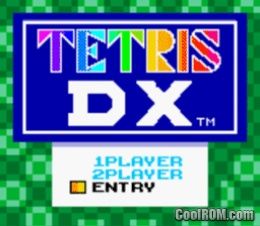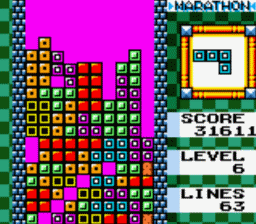Game: Tetris
Console: Nintendo Game Boy
Developer: Nintendo
Release Date: 28th September 1990
As a launch title for the original Game Boy in America and Europe, Tetris helped to popularise Nintendo's handheld console by going on to sell over 35 million copies. The game is well known worldwide and has had several different versions across various consoles including a Sega Mega Drive version which recently appeared on eBay for a whopping $1,000,000 without any takers.
From the options menu you're given the choice of either 1 or 2 player mode (2 player requiring a link cable between 2 Game Boys, both with copies of the game). Once you've chosen single player, there are 2 modes of play (the first being regular tetris play, and the second giving a total of lines to be cleared for a high score). When playing these modes there's a choice of 3 different pieces of music or if you'd prefer, silence.
I doubt there's much need for me to explain the basic gameplay of tetris, other than saying that the game is about stacking blocks of various shapes so that they fill lines and disappear. With such a simple principle to the game, there's not much more to gameplay than attempting to play for as long as possible in order to get a high score. As the number of lines that a player has cleared increases, so does the speed of the falling blocks.
Graphically the game isn't much to look at although you wouldn't expect it to be. The blocks are easy to see and identify and that's all they really need to be with gameplay as it is. Musically, the game features the classic Tetris jingle in addition to 2 other songs of slightly lesser notability. Overall despite technological and graphical advances, this is still the defining version of the game as there's not much to change; it's basically perfect as is. The only thing letting it down is its simplicity.
Rating: 82/100
Grade: B
Game: Tetris DX
Console: Nintendo Game Boy Colour
Developer: Nintendo
Release Date: 1st July 1999
With new modes, saved player profiles and more included in this update which was released almost 10 years after the original, not much has changed gameplay-wise but the most noticeable difference is that the game is in colour. From the title screen onwards there's many brightly coloured boxes and shapes which appear throughout the game and its menus.
After choosing one player mode there are four options for play, twice as many as the original game. Marathon is the recognisible classic variant of Tetris, Ultra challenges the player to accrue as many points as possible in a 3 minute time period, 40 Lines is a race against time to clear 40 lines from the screen with the high score being the shortest time, and V.S. Com mode pits the player against varying difficulties of computer opponent in a head on battle.
Gameplay is fast and colourful, working in exactly the same way as the original game. The new modes provide extra fun, and high scores can be saved via the cartridges internal battery. The controls themselves feel just a little smoother than the original version in places although not by much. For the most part the two games are one and the same.
Graphically the main difference is in colour, which does help to differentiate and identify the varied types of block occasionally. The music featured in the game is catchy and generally funk based, without a rendition of the classic theme. While this may disappoint some players, I'm glad that new themes were written as it would have been very easy to fall back on just the classic accompaniment. Overall both games are Tetris, but this has some new and colourful options.
Rating: 84/100
Grade: B
Game: Super Breakout
Console: Nintendo Game Boy Colour
Developer: Morning Star Interactive
Release Date: December 1998
The third and final classic in this review unfortunately didn't fare as well in its transition to handheld console. Anyone who's played Breakout before will know that it's basically Pong against a wall of breakable blocks instead of an opponent. You're given a limited number of balls with which to break the pattern of blocks before you, and in a lot of versions there's various powerups such as larger paddles and multiball.
In this version for Game Boy Colour, however there seems to be a few problems. For a start within seconds of starting a level, the ball gets up enough speed to easily escape your paddle and cost you a life, the paddle gets smaller as you break more blocks which increases the difficulty and there are no powerups in the game whatsoever. Lives don't reset between levels and you're lucky to reach the 2nd one with the way things are.
With five game modes you'd think there might be a little more fun, however even the multiball of Cavity mode, and the double paddle gameplay of Double mode fall flat due to the gameplay problems. Progressive mode features blocks that move toward you which hardly helps matters, and Practice mode is just Normal mode with 5 more lives. As no game is likely to last more than a minute of so, whatever mode is selected it's sort of irrelevant as to which mode is more fun anyway.
Graphically the game almost could have been on the Atari, the Game Boy Colour could and did do a whole lot better than this in other games. Although its as simple concept wise as Tetris, this just seems way more lazy on the graphical side of things. Another disappointment is that there's no music in the game whatsoever. Just a choice of block breaking sound effects, none of which are particularly impressive and make you wonder why you even get to choose. Overall this game's not even deserving of being in the same review as Tetris.
Rating: 13/100
Grade: F







No comments:
Post a Comment